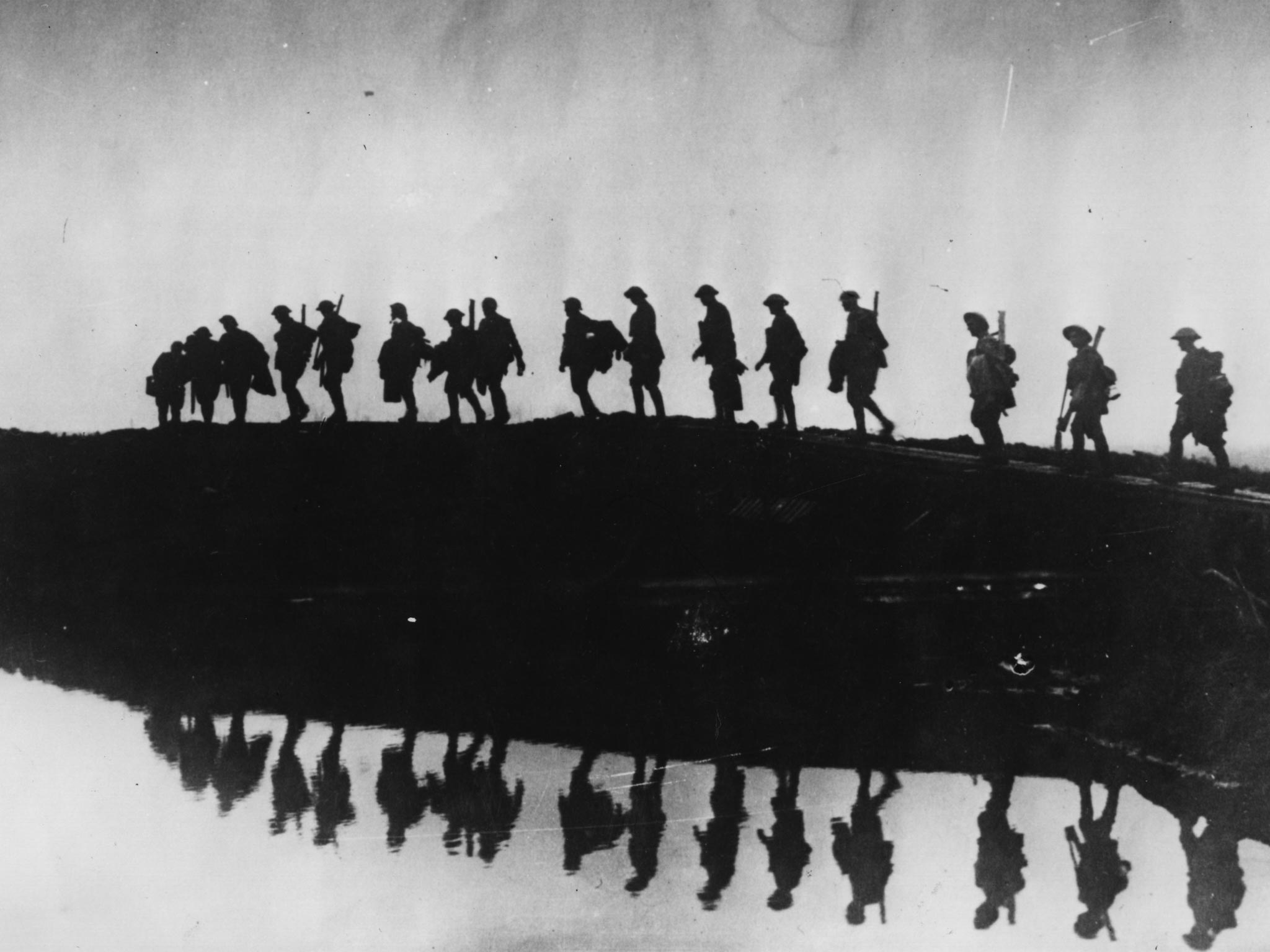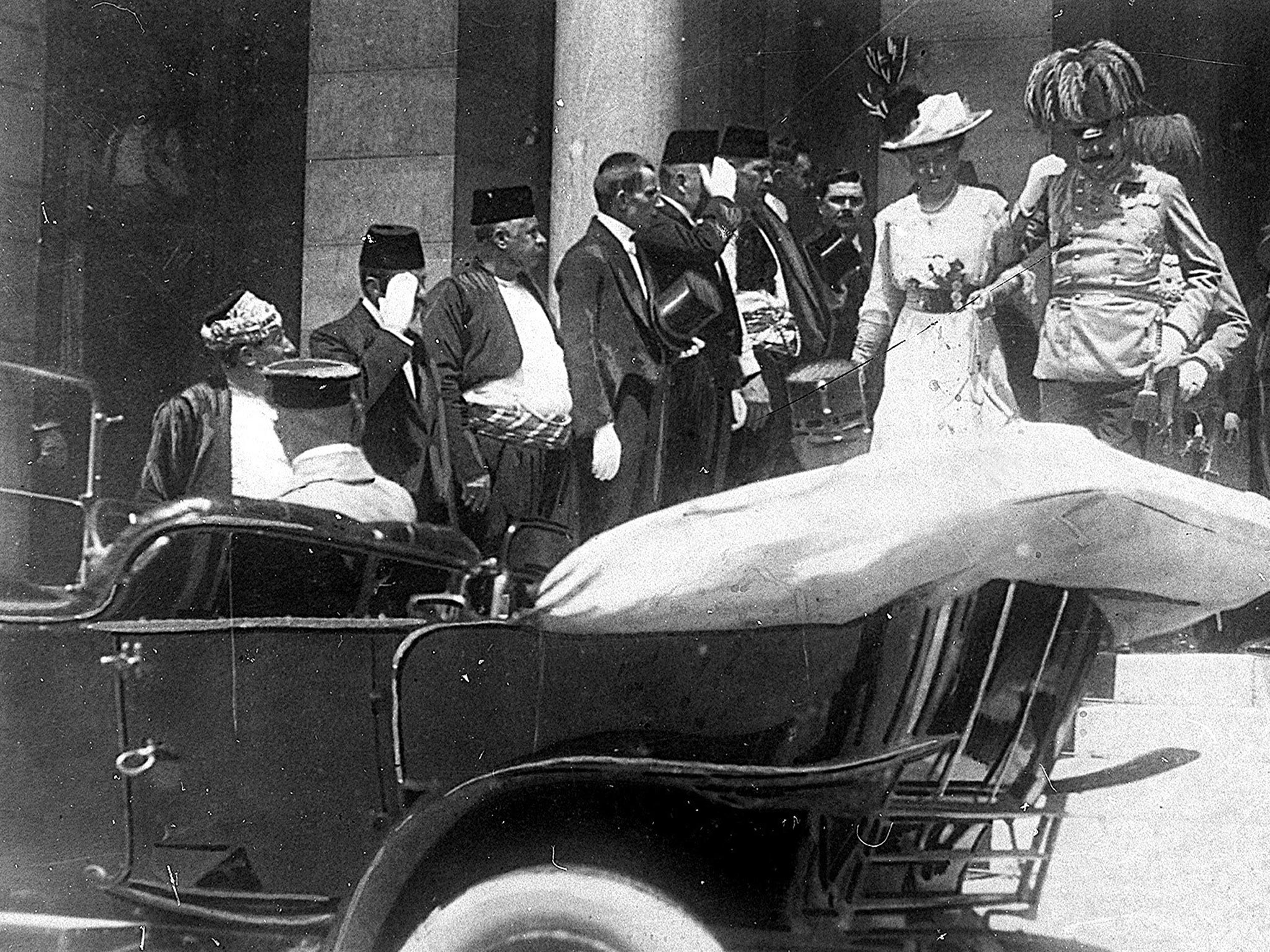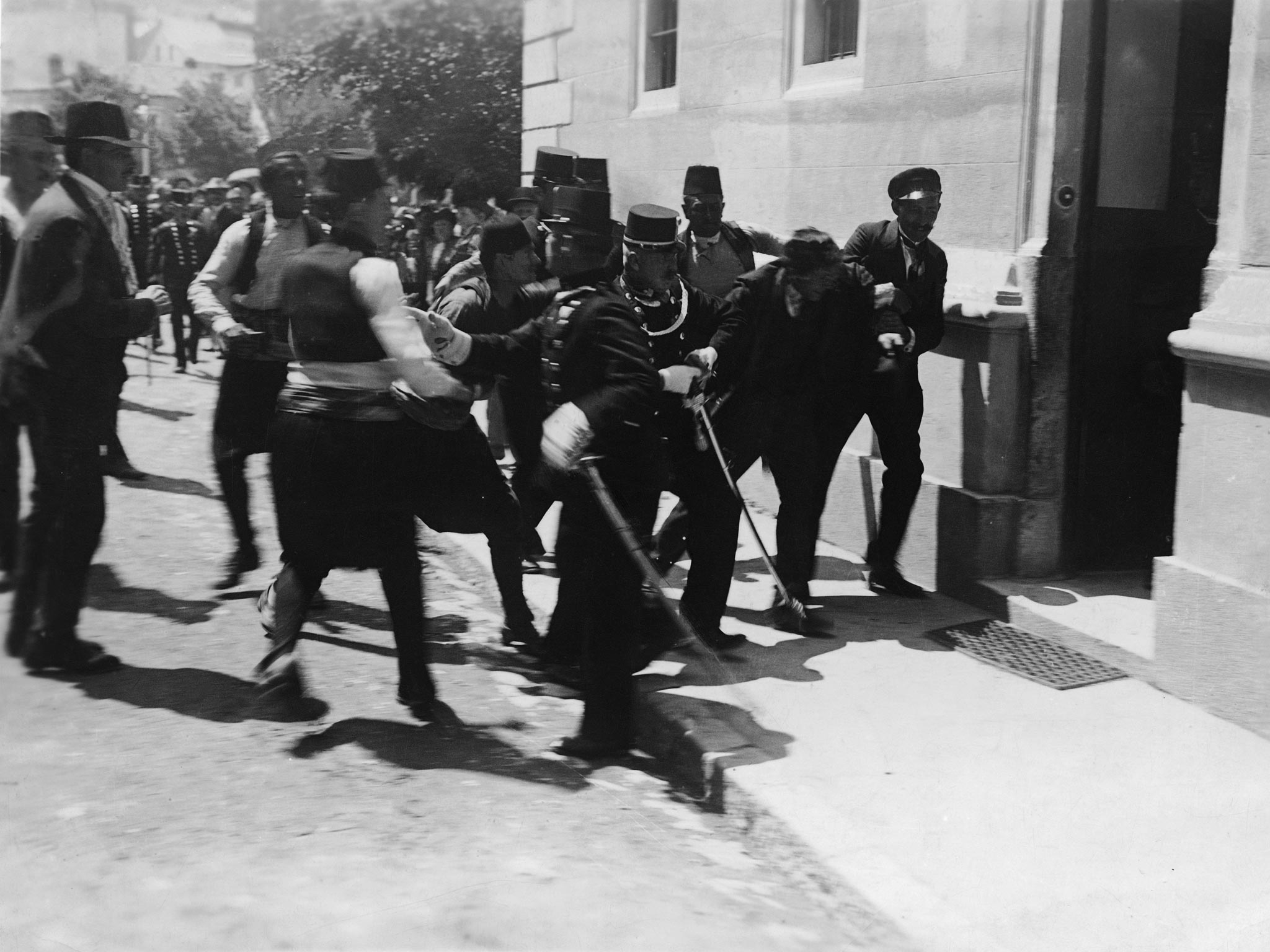A History of the First World War in 100 moments: Sarajevo, 28 June 1914 and the assassination of Archduke Franz Ferdinand that started it all
How do you remember a war that destroyed four empires, killed 18 million people and left tens of millions of other lives irreparably broken? Today, as the world prepares to mark the centenary of a conflict that left no corner of the planet untouched, we begin a unique daily series that attempts to make sense of an incomprehensibly huge chapter in human history by distilling it to a mere 100 'moments': episodes, big or small, that in one way or another capture a sense of what it was like to be caught up in the catastrophe of the First World War. Boyd Tonkin introduces our first moment

Your support helps us to tell the story
From reproductive rights to climate change to Big Tech, The Independent is on the ground when the story is developing. Whether it's investigating the financials of Elon Musk's pro-Trump PAC or producing our latest documentary, 'The A Word', which shines a light on the American women fighting for reproductive rights, we know how important it is to parse out the facts from the messaging.
At such a critical moment in US history, we need reporters on the ground. Your donation allows us to keep sending journalists to speak to both sides of the story.
The Independent is trusted by Americans across the entire political spectrum. And unlike many other quality news outlets, we choose not to lock Americans out of our reporting and analysis with paywalls. We believe quality journalism should be available to everyone, paid for by those who can afford it.
Your support makes all the difference.By around 10.30am, the panic had already subsided. Yes, it had been a vicious and unsettling terror attack. As the six-car motorcade rolled along Appel Quay, beside the river Miljacka in the heart of Sarajevo, someone had thrown a small bomb. It bounced off the car, a handsome Gräf & Stift Double Phaeton, carrying Archduke Franz Ferdinand of Austria and his Czech wife Sophie Chotek, the Duchess of Hohenberg but not – thanks to the snobbish protocols of the Vienna court – formally the Archduchess. The bomb exploded under the vehicle behind. It inflicted injuries, the worst a heavily bleeding head wound to Colonel Erik von Merizzi – adjutant to the governor of Bosnia-Herzegovina, Oskar Potiorek.
Nedeljko Cabrinovic, the teenage Serbian militant who had thrown the device, swallowed his dose of cyanide and jumped off a bridge. The low-grade toxin merely scoured his throat, and he landed on a sandbank left by the shrunken summer flow. He was arrested and led away proclaiming “I am a Serbian hero!” Elsewhere, unknown to the royal couple and their minders, assailant after assailant from two separate terror cells had given up and melted away. Muhamed Mehmedbasic had failed to launch his bomb. Paralysed with fear, Cvjetko Popovic had hidden his in a basement. Trifko Grabez quit his position and was engulfed in the milling crowds. Vaso Cubrilovic “felt sorry” for the duchess when he saw her in the open car, and would not draw his gun.
No one had died. In this province, the authorities expected spectacular stunts by Serbian radicals enraged by the official annexation in 1908 of Bosnia – already occupied for 30 years – into the Austro-Hungarian empire. In 1910, Bogdan Zerajic, of the Young Bosnia movement, had emptied a pistol at the then governor as the Bosnian parliament opened. All the bullets missed save the last, aimed at himself – for suicide attacks had lately come into vogue. What made today's incident, on the warm Sunday morning of 28 June 1914, more troubling was the security bungle that had left the royal couple's protection detail stranded at the railway station. Still, the hothead extremists represented no one but themselves. At dinner the previous evening at the Hotel Bosna in the nearby spa of Ilidze, Sophie had told a Bosnian Croat leader that “wherever we have gone, people have treated us with so much friendliness – down to the last Serb, too”.
On with the show – although Franz Ferdinand was visibly rattled. At Sarajevo town hall, the mayor, Fehim Curcic, embarked on his flowery, and unamended, speech of welcome. At this point, the Archduke's pent-up fears exploded. He butted in: “I come here as your guest and you people greet me with bombs!” Soon he regained his composure. In a gracious reply, he mentioned the population's pleasure in “the failure of the assassination attempt”. Inside the town hall, Sophie went off for a meeting with Muslim ladies (Bosnia was more Muslim than Serb), segregated so that they could remove their veils with her. She told them that she missed her children. Now it was time to resume the programme.
Potiorek advised a swift exit from the city but the couple insisted on a detour to hospital to visit the casualties. No one had informed the driver. When he turned down Franz Joseph Street, Potiorek instructed him to return to the quay. The Gräf & Stift had no reverse gear; it had to be pushed. Beside the stationary car, by a fluke, stood another young Serbian revolutionary called Gavrilo Princip. Rather than flee, he had kept his ground along the advertised royal route. Princip fumbled with his bomb but failed to detonate it. Instead, from five feet away, he fired two shots. Sophie was hit in the stomach; Franz Ferdinand in the neck. Both bullet wounds proved fatal. As he tried to staunch the blood, Count Harrach heard the Archduke say, “Sophie, Sophie, don't die – stay alive for our children.” Just after 11am, both were dead.

After a beating by furious bystanders, Princip was taken into custody. As minors, none of the Belgrade-based trio tasked with the assassination was subject to the death penalty under the empire's law. Princip received a 20-year sentence and died in 1918 of consumption, exacerbated by grim conditions, in the military jail at Theresienstadt. Other, adult, conspirators did later hang.
A second cell, made up of local Serbs, had been put in place as one of several distractions to blur the conspiracy's chain of command. Students enraptured by the romance of the Serbian struggle against the Habsburg yoke, Princip, Cabrinovic and Grabez had pored over the preparations for this high-impact assassination. Independent Serbia – to its friends a brave powerhouse of Slavic identity; to its foes a rogue state that sponsored indiscriminate terror – had emerged the biggest winner from the two bloody Balkan wars of 1912-1913. Its territory had expanded, mostly at the expense of the Ottoman empire. Yet Bosnia remained under the Viennese boot. That it held more Muslims and Catholics than Orthodox Serbs hardly troubled “irredentist” nationalists who believed that “where a Serb lives, there is Serbia”.
Princip and his co-conspirators belonged to “Unity or Death!”, a remarkably open “secret” society with contacts at the top of the Belgrade government. Most people knew the group by a more colourful name: the Black Hand. Via the intermediary Milan Ciganovic, the trio reported to a Black Hand chieftain, Voja Tankosic. Behind him stood one of Europe's most formidable secret agents, the head of Serbian military intelligence: Colonel Dragutin Dimitrijevic, known as “Apis” after the Egyptian bull god. Apis often acted alone, though not unobserved. Nikola Pasic, the Serbian Prime Minister and a wily survivor, both used him and feared him. Only schoolchildren and saloon-bar chatterers any longer seek one-word replies to the question, “Who caused the First World War?” If that inquiry had an answer, then –although only in a deeply myopic perspective – one non-trivial response might be: “Apis”.
In the days after 28 June, opinions as to the gravity of the outrage varied. Although the Vienna press fulminated about this “blow of fate”, in Paris, St Petersburg, London and Berlin it looked more like a grotesque but routine Balkan atrocity. Besides, no one beyond his family seems to have liked the heir to the Austro-Hungarian dual monarchy very much. The author Arthur Schnitzler referred to his “appalling unpopularity” in a diary entry on the day of the killings. Vienna politician Josef Redlich reported the next day that “there is no sense of grief” in the city. Most accounts of the assassination as a world-historic turning-point date from much later – by the great nostalgist Stefan Zweig, for instance, whose memoirs lament “the shot that in a single second was to shatter the world of security and creative reason”. At the time, the many enemies of Austria rejoiced, often with unseemly glee. “Grazie Serbia!” piped up one Italian newspaper. More fool them – but not yet.
In his heavy-handed way, the peace-loving Franz Ferdinand had envisioned the reform of the creaking dual monarchy into a multi-ethnic commonwealth, a United States of Greater Austria made up of 15 equal peoples. He hated the idea of even a regional conflict. Against Vienna belligerents such as the army chief Baron Conrad von Hötzendorf, he vociferously backed alternatives to military entanglements in the Balkans or beyond. In October 1912, as the first Balkan campaign threatened to suck in Austria, the Archduke warned the Foreign Minister, Count Leopold Berchtold, about the dangers of entering the “witches' kitchen of war”.

Even after his murder, that witches' kitchen felt more like myth than fact. Europe, after all, had weathered some storms over the past few years. Both Balkan wars had almost dragged in other powers, most nearly during the “winter crisis” of 1912-1913. Then, a fresh-minted pro-Serbian policy in Russia took the Foreign Minister, Sergei Sazonov, to the brink of mobilisation. In 1911, the Agadir incident, when Germany sent a warship to Morocco as a riposte to French claims of sole control, had tested the limits of British support for France under the Entente Cordiale of 1904. It resulted in a few scary weeks.
Agadir ended in November 1911, with the usual imperialists' carve-up. In December 1913, Russia unsheathed its diplomatic sabres again when General Otto Liman von Sanders took command of a Turkish army corps in Constantinople. But the Ottoman navy already employed a British admiral, Arthur Limpus. Neither France nor Britain felt very much alarmed. Europe in 1914 was a multi-polar system in which five big powers not only played chess with one another but simultaneously within their own rivalrous cabinets and chancelleries. It expected to witness sporadic flare-ups. These were controlled explosions.
Thousands of books have sought to explain how a nasty local outrage in Sarajevo – albeit one engineered by a hostile state – led to the end of the world. For the world of 1914 did end during the four succeeding years and their decades-long aftermath. Some 10 million combatants died, and at least eight million civilians. The wounded, a huge proportion disabled for life, numbered more than 21 million. Four empires succumbed immediately – the Russian, Austrian, German and Ottoman. After a delusionary bounce of post-war acquisitions, two more expired of their wounds later: the French and British. Without the Great War, and its botched outcomes, the Second World War is inconceivable. By some lights, the “short 20th century” that began with the guns of August 1914 only closed with the fall of the Soviet Union in 1991. Look at Ukraine, and Crimea today, and it would not be absurd to hear the echo of those weapons – and of Princip's .38 revolver on the corner of Franz Joseph Street.
Hindsight makes sages of us all. But no one in Europe on 28 June 1914 was in possession of a working crystal ball. For all the “future war” genre of speculative fiction during the Edwardian years – such as Erskine Childers' bestseller The Riddle of the Sands in 1903 – sober heads proclaimed that globalised commerce and a mesh of close alliances made general conflict unthinkable. In his peace-mongering tract of 1909, The Great Illusion, Norman Angell had mocked big-power war as a futile throwback.
Shortly before Sarajevo, many prudent observers thought that Europe had begun to go off the boil. In Britain, the apparently anti- German – more strictly, pro-Entente – policies of the Foreign Secretary, Sir Edward Grey, had come under withering criticism by a doveish majority within his Liberal Party. Inflammatory Anglo-German “press wars” had ceased by 1912. The mandarin policy-maker Arthur Nicolson wrote in May 1914 that “since I have been at the Foreign Office I have not seen such calm waters”. Yet, five weeks after 28 June, Europe was at war.
The “July Crisis” of 1914 remains arguably the most complex sequence of events in all European history. Still, not a single word of its script was written in advance. Luckily, we can now trace that chain – or rather cluster – of occurrences armed with one of the greatest of those long shelves of explanatory books: Christopher Clark's masterpiece, The Sleepwalkers. As Clark makes clear, every deed – or refusal to act – counted. “Short-term, contingent realignments” shifted rapidly across an “opaque and unpredictable” system. The many later “narratives of inevitability” substitute consoling fiction for messy truth. They mean that “contingency, chance and agency are squeezed out of the field of vision”.
Focus on selected moments, as The Independent's new series does, and that “agency” returns to centre stage. Each choice and chance genuinely mattered, although none made a decisive difference in itself. Its agents, like its millions of victims, lived the First World War not as a vast span or grand plan but day by day, crisis by crisis, shock by shock. Spotlight key events and we may, just for a while, glimpse that lost world before hindsight. By 24 July, after Austria had drawn up an ultimatum to Serbia, the British Prime Minister, Herbert Asquith, could indeed tell his confidante Venetia Stanley in one of his intimate letters that “We are within measurable or imaginable distance of a real Armageddon”. Then he consoles himself, and her. “Happily, there seems to be no reason why we should be anything more than spectators.”
Join our commenting forum
Join thought-provoking conversations, follow other Independent readers and see their replies
Comments